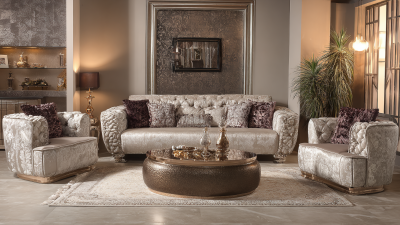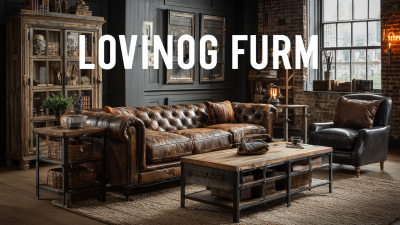As sustainable living gains traction, homeowners are increasingly seeking eco-friendly solutions that enhance their living spaces while minimizing their environmental footprint. In the realm of interior design, "Living Room Furniture" has evolved to reflect these changing values, blending aesthetics with sustainability. According to a recent report by the Furniture Industry Research Association, the demand for sustainable furniture is projected to grow by 25% over the next five years, driven by a heightened consumer awareness of environmental issues and the desire for healthier living spaces.
Incorporating sustainable materials, such as reclaimed wood, bamboo, and recycled metal, not only contributes to reducing waste but also adds unique character to any living room. A study conducted by the Sustainable Furnishings Council indicates that over 70% of consumers are willing to pay a premium for eco-friendly furniture options. This shift in consumer behavior highlights an impressive opportunity for manufacturers and designers to revamp traditional offerings and embrace innovative, responsible design practices.
As we explore the top 10 sustainable living room furniture trends, we will uncover ways to create stylish, functional spaces that reflect personal values while supporting a more sustainable future. The integration of environmentally conscious designs not only elevates the overall aesthetic of the living room but also fosters a sense of responsibility towards the planet, making every piece of furniture a step towards a greener world.

Sustainable materials are transforming the landscape of living room furniture, paving the way for eco-friendly designs that are both stylish and responsible. As more consumers prioritize environmental impact, furniture makers are incorporating materials like reclaimed wood, bamboo, and recycled metals. These options not only reduce waste but also add unique character to your living space, with each piece telling its own story and offering durability that lasts.
When revamping your living room with sustainable furniture, consider these tips: First, look for certification labels, such as FSC (Forest Stewardship Council) for wood products, which ensures that materials are sourced from responsibly managed forests. Second, explore options made from natural fabrics like organic cotton, linen, or hemp, which are often less harmful to the environment than synthetic alternatives. Lastly, embrace vintage or second-hand pieces; reusing furniture not only cuts down on waste but also adds a distinctive charm that new items often lack.
By choosing furniture crafted from sustainable materials, you contribute to a healthier planet while enjoying a functional and aesthetically pleasing living space. This trend demonstrates that style and sustainability can seamlessly coexist, allowing for the creation of a home that reflects your values and taste.
Sustainable living room furniture trends are rapidly evolving, driven by innovative design practices that prioritize environmental consciousness without compromising style. One prominent trend is the use of reclaimed materials. Furniture makers are increasingly sourcing wood and metals from old structures, giving these materials a new life while reducing waste. This not only minimizes the depletion of natural resources but also adds character and history to modern interiors.
Another exciting design trend is the integration of modular furniture systems. These adaptable pieces can be reconfigured to suit different needs and spaces, promoting longevity and reducing the need for additional purchases. Brands are focusing on creating products that are not only aesthetically pleasing but also functional and sustainable. Furthermore, the rise of eco-friendly textiles, such as organic cotton and recycled polyester, is transforming upholstery choices. Consumers are now more inclined to select materials that contribute to a healthier environment, aligning their personal style with their values while enjoying a chic and sustainable living space.
The rise of upcycled and reclaimed furniture reflects a significant shift in contemporary interior design, as homeowners seek both style and sustainability in their living spaces. Upcycling involves transforming discarded or unused items into functional pieces, thus reducing waste and environmental impact. This trend resonates with the growing demand for eco-friendly decor, as consumers are increasingly aware of the importance of sustainable living. By incorporating vintage furniture and materials, individuals not only preserve history but also add unique character to their homes.
Experts suggest several tips for successfully purchasing second-hand furniture to upcycle. Scanning local thrift shops, flea markets, and online marketplaces allows buyers to hunt for hidden treasures while saving money. The key is to envision the potential transformation of a piece, whether it's a fresh coat of paint or a creative repurposing. As vintage styles continue to emerge in fashion and home decor, embracing these trends can lead to innovative designs that tell a story, reflecting personal style and sustainable choices in modern interiors.
| Furniture Type | Material | Sustainability Feature | Average Price ($) | Popularity Score (1-10) |
|---|---|---|---|---|
| Upcycled Sofa | Fabric & Wood | Reused Materials | 800 | 9 |
| Reclaimed Wood Coffee Table | Reclaimed Wood | Environmentally Friendly | 500 | 8 |
| Vintage Armchair | Wood & Upholstery | Restored Item | 350 | 7 |
| Eco-Friendly Side Table | Bamboo | Renewable Resource | 200 | 8 |
| Salvaged Wood Bookshelf | Salvaged Wood | Resource Conservation | 700 | 6 |
As consumer awareness around environmental issues increases, so does the demand for sustainable home furnishings. Homeowners today are looking for furniture that not only enhances their living spaces aesthetically but also aligns with their personal values of sustainability and responsibility. This shift in consumer preferences is evident in the growing popularity of materials that are eco-friendly, ethically sourced, and designed for longevity.
Innovative designs that incorporate recycled materials or sustainably harvested wood are gaining traction. Consumers are particularly drawn to brands that transparently share their sourcing practices and production processes. Additionally, the concept of upcycling—transforming old furniture items into new, functional pieces—has appealed to environmentally conscious buyers who wish to minimize waste while adding character to their living rooms.
As the market responds to these evolving preferences, we can expect more retailers to prioritize sustainability, making it easier for consumers to choose environmentally friendly options when revamping their living spaces.
Investing in sustainable living room furniture not only enhances your space aesthetically but also offers significant economic benefits. According to a report by the Sustainable Furnishings Council, eco-friendly furniture can save homeowners up to 30% on energy costs over time due to the use of sustainable materials and energy-efficient manufacturing processes. Additionally, sustainable pieces often boast longer lifespans, reducing replacement frequency and minimizing the long-term expenditure on furniture.
When selecting sustainable options, consider furniture made from reclaimed wood or certified sustainable materials, which can potentially lower material costs. Furthermore, choosing local artisans can help reduce shipping expenses and support the local economy. A study by the American Home Furnishings Alliance emphasizes that consumers are more willing to pay for sustainability, indicating that the initial investment in eco-friendly furniture pays off through increased resale value and durability.
Tips:






